
Ludwigskirche
Encyclopedia
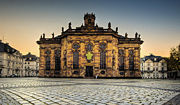
Saarbrücken
Saarbrücken is the capital of the state of Saarland in Germany. The city is situated at the heart of a metropolitan area that borders on the west on Dillingen and to the north-east on Neunkirchen, where most of the people of the Saarland live....
, Germany
Germany
Germany , officially the Federal Republic of Germany , is a federal parliamentary republic in Europe. The country consists of 16 states while the capital and largest city is Berlin. Germany covers an area of 357,021 km2 and has a largely temperate seasonal climate...
, is a Protestant
Protestantism
Protestantism is one of the three major groupings within Christianity. It is a movement that began in Germany in the early 16th century as a reaction against medieval Roman Catholic doctrines and practices, especially in regards to salvation, justification, and ecclesiology.The doctrines of the...
baroque
Baroque
The Baroque is a period and the style that used exaggerated motion and clear, easily interpreted detail to produce drama, tension, exuberance, and grandeur in sculpture, painting, literature, dance, and music...
style church. It is the symbol of the city and is considered to be one of the most important Protestant churches in Germany, along with the Dresden Frauenkirche
Dresden Frauenkirche
The Dresden Frauenkirche is a Lutheran church in Dresden, eastern Germany.Built in the 18th century, the church was destroyed in the firebombing of Dresden during World War II. It has been reconstructed as a landmark symbol of reconciliation between former warring enemies...
and the St. Michaelis Church, Hamburg ("Michel").
History
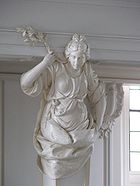
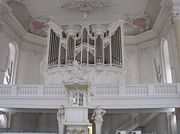
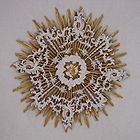
Consecration
Consecration is the solemn dedication to a special purpose or service, usually religious. The word "consecration" literally means "to associate with the sacred". Persons, places, or things can be consecrated, and the term is used in various ways by different groups...
of the church took place on August 25, 1775, with a church service and a cantata composed especially for the occasion.
In 1885-1887 and in 1906-1911, the church underwent restoration. During the Second World War, Ludwigskirche was severely damaged. After a bombing on October 5, 1944, only the surrounding walls remained. Rebuilding began in 1949, however it has still not been completed. A fundamental reason for this long delay was the fierce dispute, which lasted from the 1950s into the 1970s, about whether the baroque interior, which had been completely lost, should also be reconstructed. At first, it had been agreed to restore the exterior, with a modern interior, but this plan was finally abandoned. At this time (2007), the "Fürstenstuhl" (i.e., the royal seating in the gallery across from the organ) in the interior and some of the balustrade figures on the outside are still lacking.
Design
The ground plan is shaped somewhat like a Greek cross; the arms are 38.5 m and 34.2 m long and are each 17 m wide. There are niches on the outside which contain statues of the four EvangelistFour Evangelists
In Christian tradition the Four Evangelists are Matthew, Mark, Luke, and John, the authors attributed with the creation of the four Gospel accounts in the New Testament that bear the following titles:*Gospel according to Matthew*Gospel according to Mark...
s by Francuß Bingh. The stone balustrades were decorated with 28 figures, also by Bingh, depicting the apostles, prophet
Prophet
In religion, a prophet, from the Greek word προφήτης profitis meaning "foreteller", is an individual who is claimed to have been contacted by the supernatural or the divine, and serves as an intermediary with humanity, delivering this newfound knowledge from the supernatural entity to other people...
s and other Biblical
Bible
The Bible refers to any one of the collections of the primary religious texts of Judaism and Christianity. There is no common version of the Bible, as the individual books , their contents and their order vary among denominations...
people.
The interior of the church is decorated with ornamental stucco
Stucco
Stucco or render is a material made of an aggregate, a binder, and water. Stucco is applied wet and hardens to a very dense solid. It is used as decorative coating for walls and ceilings and as a sculptural and artistic material in architecture...
(cartouche
Cartouche
In Egyptian hieroglyphs, a cartouche is an ellipse with a horizontal line at one end, indicating that the text enclosed is a royal name, coming into use during the beginning of the Fourth Dynasty under Pharaoh Sneferu, replacing the earlier serekh...
s, rocaille). Each of the four arms of the cross has a gallery supported by two to four caryatid
Caryatid
A caryatid is a sculpted female figure serving as an architectural support taking the place of a column or a pillar supporting an entablature on her head. The Greek term karyatides literally means "maidens of Karyai", an ancient town of Peloponnese...
s. The floor is made of sandstone
Sandstone
Sandstone is a sedimentary rock composed mainly of sand-sized minerals or rock grains.Most sandstone is composed of quartz and/or feldspar because these are the most common minerals in the Earth's crust. Like sand, sandstone may be any colour, but the most common colours are tan, brown, yellow,...
.
Special features of the interior are the arrangement of the church by and large along the width of the church, on the one hand, and the placement of the altar, pulpit and organ over each other (a so-called "pulpit-altar"), on the other hand. The arrangement with the altar, pulpit and organ is rather unusual for a Lutheran church, but it had already been used by Stengel in some of his earlier buildings.
Stengel designed not only the overall plan of the church and the surrounding palaces, from the handles for the doors to the overall grounds, but he also fit the church and the square into the two main viewing axes of the city's layout. One of these axes, from the "Alten Kirche" (Old Church) in the city district of St. Johann, through the Wilhelm-Heinrich-Straße of today and the main entrance, up to the altar, is still visible today. The other axis points over the exit, which faces the Saarland state chancellery today, toward the former royal summer residences on Ludwigsberg, the so-called Ludwigspark.
The restoration of the original white paint on the exterior is still currently being disputed. This had existed until 1945 and it would also be important for fitting the church into the square, but it has become quite a strange idea to many local residents in the past decades.
Ludwigsplatz
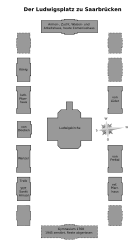
Other
In 1965, Ludwigskirche was depicted on the series of stamps, Hauptstädte der Länder der Bundesrepublik Deutschland (Capitol cities of the states of the Federal Republic of Germany).As the symbol of the Saarland state capitol of Saarbrücken, Ludwigskirche will be shown on the German 2 euro commemorative coin in 2009.
Foreign language guidebooks often describe Ludwigskirche as "église St. Louis" or "St. Louis church". However, it is not (in contrast to the Catholic church, St. Ludwig in Saarlouis
Saarlouis
Saarlouis is a city in the Saarland, Germany, capital of the district of Saarlouis. In 2006, the town had a population of 38,327. Saarlouis, as the name implies, is located at the river Saar....
) dedicated to Saint Louis
Louis IX of France
Louis IX , commonly Saint Louis, was King of France from 1226 until his death. He was also styled Louis II, Count of Artois from 1226 to 1237. Born at Poissy, near Paris, he was an eighth-generation descendant of Hugh Capet, and thus a member of the House of Capet, and the son of Louis VIII and...
, but named for Ludwig von Nassau-Saarbrücken, who completed its construction.
Literature
- Georg DehioGeorg DehioGeorg Gottfried Julius Dehio , was a Baltic German art historian ....
: Handbuch der deutschen Kunstdenkmäler. Rheinland-Pfalz, Saarland. Deutscher Kunstverlag. Munich 1984. pp. 889–892. ISBN 3422003827 in German - Dieter Heinz: Ludwigskirche zu Saarbrücken. 2nd edition. Saarbrücken 1979. ISBN 3477000617 in German

